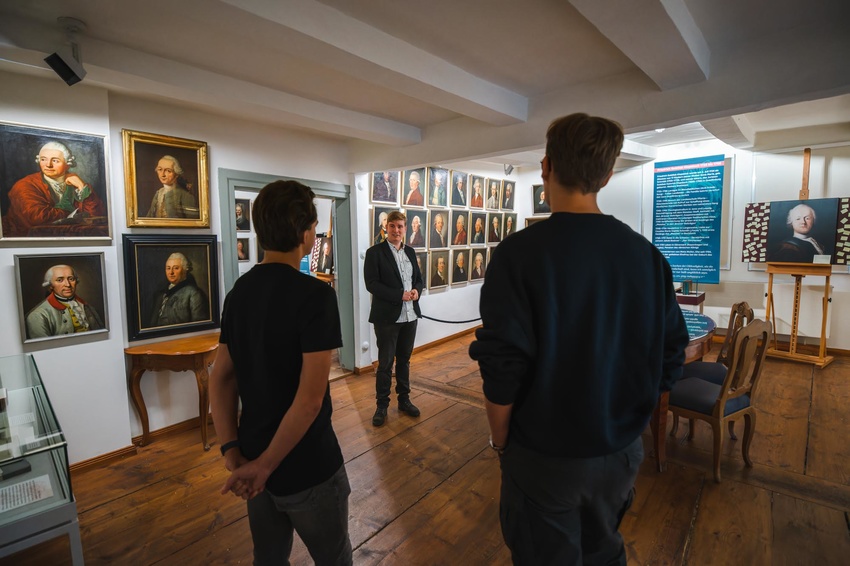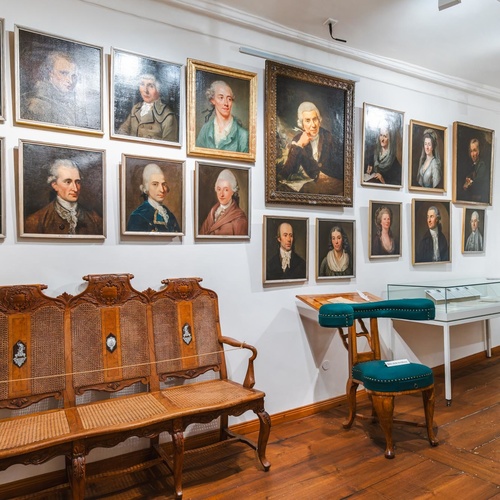
The Gleimhaus offers a variety of points of contact for an entertaining and eventful visit. The theme of friendship is always present, in the friendship letters, in the pictures in the Temple of Friendship or in the library, which was also dedicated to friends.
By public transport: Coming from the main railway station, please take tram line 1 in the direction of "Friedhof" and get off at "Hoher Weg". Walk up the stairs to the cathedral and you will find yourself directly in front of the Gleimhaus. Walk from the main railway station: approx. 25 min.
By bike: Covered parking spaces in front of the museum. An e-bike battery charging station (locker with 230-volt earthed socket - own charging cable required) is located at the Halberstadt Tourist Information Centre on Holzmarkt, approx. 350 m away.
By car: There are no parking spaces available at the Gleimhaus. Please park in the surrounding public car parks (subject to a charge) or in the CONTIPARK Halberstadt Zentrum multi-storey car park. Free large car park "Am Dom" (Unter den Weiden 11, 38820 Halberstadt) - approx. 5-10 min walk.

The permanent exhibition in the Gleimhaus invites visitors to immerse themselves in the life and work of the poet and collector Johann Wilhelm Ludwig Gleim. It opens a window onto his important culture of friendship and letters as well as the literary history of the Enlightenment. In Gleim's "Freundschaftstempel" (Temple of Friendship) on the upper floor of the historic house, visitors encounter the great personalities of this era in a lively way - including greats such as Lessing, Herder, Klopstock, Nicolai and the remarkable poet Anna Louisa Karsch. The portraits of these thinkers and artists create a link to the Enlightenment and its world of ideas. The visit is made particularly interactive by an audio installation: selected portraits can be "brought to life" using voice control as they begin to talk about themselves and their time. This turns the exhibition into a place of living history, allowing visitors to experience the thoughts and dialogues of the Enlightenment era in a very special way.
Discover a diverse selection of specialised literature, fiction, children's books as well as lovingly designed souvenirs and exclusive items inspired by our collections - conveniently available online or directly on site in the museum shop.
Feel free to visit our shop in person at Gleimhaus, or give us a call. (03941/6871-0)
In 2021, the Gleimhaus launched the interactive video installation „Gleims Bücher – Poesie-Performance mit André Eisermann“ (Gleim's Books - Poetry Performance with André Eisermann), designed for expansion. This installation allows evening strollers on Halberstadt's Cathedral Square to experience literary hits from the Enlightenment era.
The Arbeitstagung Kultureller Gedächtnisorte KGO (Working Conference of Cultural Places of Remembrance KGO) is an association of currently 22 nationally significant cultural institutions from the new federal states. It was founded in Quedlinburg in 2003 as a result of the so-called Blaubuch (blue book).
The task of the Arbeitstagung Kultureller Gedächtnisorte is to promote and preserve the cultural heritage of the cultural institutions in the eastern German federal states, which are classified as "nationally significant" in the Blaubuch. The goal is to establish these museums, collections, archives, and memorials sustainably in the awareness of politics and the public.
With the installation of large reprinted portraits from the Gleimhaus, a circle is completed. Nature and culture meet in the Halberstadt Spiegelsberge. Gleim's superior, Ernst Ludwig Freiherr von Spiegel zum Desenberg, acquired and designed the Spiegelsberge landscape park. In a short film, you will meet the cathedral secretary Gleim, his niece Sophie Dorothea, the eloquent poetess Karsch, the Baron von Spiegel, and the beautiful Frau von Branconi.
For Gleim, friendship was a kind of intellectual and social motor that brought people together and contributed to the development and dissemination of knowledge and culture. His life and work are an outstanding example of the importance of friendship in 18th century German literature. Watch the introductory film to our exhibition.